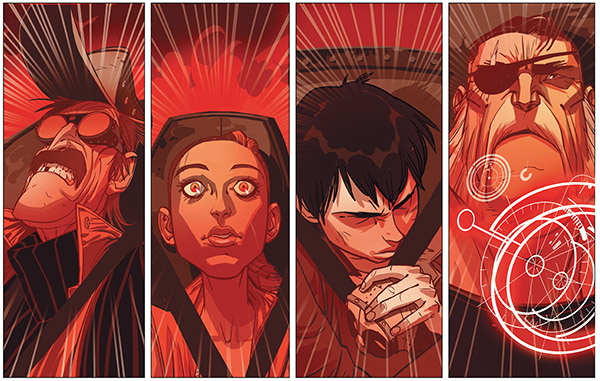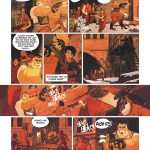WARSHIP JOLLY ROGER is a sprawling space opera filled with the sort of drama and adventure fans of STAR WARS and BATTLESTAR GALACTICA will very likely appreciate, yet it has a very unique look and feel to it. Miki, what first inspired the idea for WARSHIP JOLLY ROGER?
MIKI: Well, the main idea was to bring back the feeling of pure adventure that science fiction had in the 70s and 80s, when the first series of Star Trek were part of the pop culture, and movies like 2001 a Space Odyssey, Planet of the Apes, Blade Runner, just to give a few examples, were big hits on cinemas. I think these movies were giving people the possibility to speculate with different futures for mankind, or the dangers of uncontrolled evolution of technology and genetics. To me it’s really important that we discuss these issues as soon as we can because science fiction of today will be the science of tomorrow.
So, at the same time I was trying to create something that had a strong entertainment element to it, but also to create an ethical and philosophical debate about how we want to build our society.
In developing the story, what elements did you want to do differently to make this feel so original?
MIKI: First of all, creating characters that would not represent the archetype of “the good guys.” The main characters in Jolly Roger are constantly dealing with the mistakes they committed in the past, or they are victims of their own circumstances. They suffer because they were in the wrong place, or other people manipulated them on their own benefit.
In movies like the first Star Wars (which I like, by the way) there is a very simplistic point of view of good and evil, very common in western societies. You can be on the good side or on the bad side, if you are a good guy you will dress white or brown, if you are not, you will dress black or red… even the aliens have the same sense of good and evil as humans! I find this simplification dangerous.
In real life, it’s way more difficult to differentiate what is good or not — where is the truth and where is the lie? We all have both sides, and one cannot exist without the other. If some day we contact an intelligent lifeform, I doubt very much that they will have the same ethics and understanding of the universe that mankind has. I think Sylvain understood that idea perfectly, and probably that’s why it was so easy to connect with his direction for the story.
Sylvain, you have written many, many books of many different genres, including several successful original sci-fi titles, such as ORBITAL. What drew you to WARSHIP?
SYLVAIN: Actually, this project started in a very different way from how I’m use to working. I usually start to write my own story, creating my own characters, my own universe, storylines, and script, except when it’s an adaptation, from a novel for example. But with “Warship Jolly Roger,” it was actually Dargaud Publishing (the original Belgian publisher of the project) that contacted me. Miki had created the “Warship Jolly roger” universe on his side, he already had a lot of designs and some ideas for characters like Munro, Thirteen, Ook, Alisa, and Kowalski, and he wanted to have a professional scriptwriter develop his universe so he could focus on the graphic side, while continuing to be involved in the storyline. So I wrote a script for the first book from the roots of what he had already created, adding a lot of new elements and characters, which Miki and Dargaud liked, so that’s how I become the writer on “Warship Jolly Roger.”
The story is filled with mystery, betrayal, fantasy, technology, heartbreak, and revenge. What elements of the story do you find the most interesting and exciting to write?
SYLVAIN: For me, the core of “Warship Jolly Roger” is the “space pirate” theme. When I was a kid, I was a big fan of this Japanese anime, Captain Harlock, and I always had in mind writing my own version of a space pirate. So I was really excited when I received the proposition to develop “Warship Jolly Roger,” and was also amazed by the fantastic visual universe Miki was creating. But then, it’s really a mature, twisted, and violent version of the myth, as Jon Tiberius Munro becomes a space pirate after escaping from the prison he was serving a 170 years sentence for being a war criminal, having killed more than 10,000 civilians during an attack on a city during a previous civil war. The challenge was to develop a character that actually did that horrible thing he’s guilty of, no doubt about it, because as a military pawn, Munro was simply following orders from his hierarchy, without questioning them. But in the end, he’s the only one convicted for this terrible crime, the politician that gave the order, President Vexton, remains in charge and out of trouble. So Munro becomes a “space pirate” in order to achieve vengeance against Vexton.
I always find it interesting to dig into this kind of character, and what could be the different sides of him. Yes, Munro is a war criminal, but he’s also a family guy, he has a wife, two kids, he loves them, and he has also his own sense of honor that includes the belief that a soldier must always follow orders, which is what brought him into this situation. I guess it’s like with the Tony Soprano character, from the HBO show. As a viewer, you follow him, have empathy for him, because he has some good sides, makes you laugh, or cry, but at the end, he’s still this Mafioso killing people and ruining other’s lives. So, mixing those twisted moral elements with an epic science fiction space pirate story was what made me want to write this story first.
Were there influences that you specifically wanted to pay tribute to with the story?
MIKI: I remember on the early stage of character creation I was reading Treasure Island by Robert Louis Stevenson and I was fascinated by the character of Long John Silver and his relationship with Jim Hawkins. So I used them as an inspiration when I was working on Captain Munro and Thirteen, and I tried to capture that spirit and translate it to science fiction genre.
Miki, your artwork has an extremely dynamic style, like big-budget feature-quality 2D animation. What inspires your work?
MIKI: Thank you very much! The truth is that this came out as a result of the first years of my career working in animation and video games. Although I read a lot of comics, the classic cartoons and animated movies I watched as a kid had a deep impact on my visual education. The possibility of creating a new world and seeing it in movement totally captured my imagination, and I always dreamed I would be able to do that someday.
The problem: money. Animation costs a lot of money. Then I discovered that comics, being a different language in itself, allowed the reader to fill the blank spaces between frames in a more interactive way than animation, and was also extremely cheap to produce, so here was the solution.
Still, lately my style is evolving in a way that tends to differentiate from animated movies, but I can´t bring it further [in this series] as I need to stick to the style I created for the first WJR.
How did you get into drawing and design as a career?
MIKI: It just happened. I always loved drawing, but I was very conscious that it was a difficult market, full of very talented people. So I tried to work harder than anyone else. When there was an opportunity, I would take it, no doubt. Even if I didn’t know how to accomplish the job, it would be a challenge. For that reason, I was getting small jobs since I was a student. Usually there was very little money involved, and the conditions were terrible. But I didn’t care. Eventually, conditions got better, the salary too, and I would like that to continue exponentially!
What other projects have you worked on, and did they contribute to your vision for WARSHIP?
MIKI: This is my first personal project, and my first comic book. In terms of aesthetics, the style I developed is the result of all I learned in animation, storyboarding, illustrating for advertising companies, etc. These were not personal works, but they had a creative element to them that I used to develop a style.
What contributed to creating the characters and universe of WJR was everything I saw on a screen or printed on paper since I was a kid. From Tom&Jerry to R. Crumb´s comics, from Disney and Warner movies to Alien and Terminator, from Bradbury and Philip K. Dick novels to Alan Moore dystopias… all blended into a unique mix, trying to create a unique flavor.
The story continues beyond the first two chapters featured in BOOK ONE. Without giving away any spoilers, what cam fans look forward to in the next Book?
SYLVAIN: Things will get harder and harder for everyone until the end, that’s for sure. So you will have at the same time more and more alien creatures, more space battle, but also a political side of the universe that will grow around Vexton’s character and his fight against Munro which will impact his political career. It will be a “House of Cards” mixed with a hardcore version of “Star Wars,” or perhaps a “Battlestar Galactica” mixed with “Captain Harlock” sort of!























